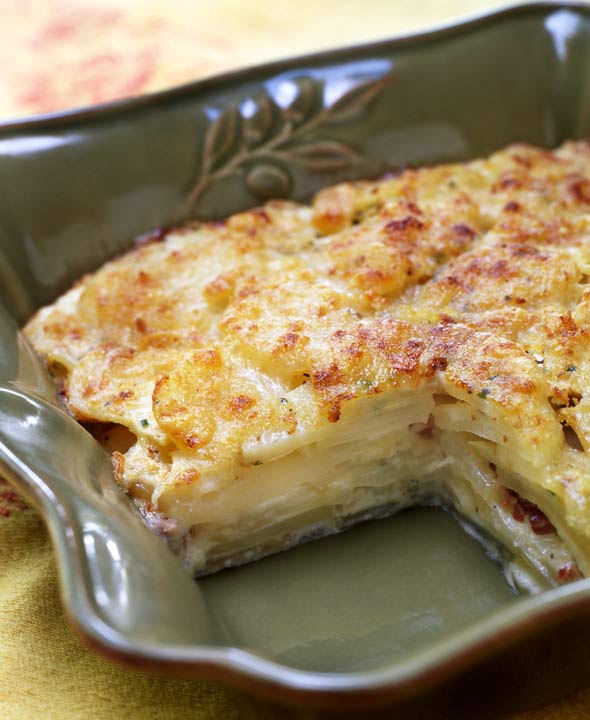
Jump To
Celery root, perhaps one of the ugliest looking vegetables on the planet, gets a makeover in this luscious gratin. –David Leite
LC Celery Root Note
Celery root. Celeriac. Whatever you call it, the root vegetable can take a little acclimating if you’re not accustomed to its robust celery-like smack. Which is exactly why we rely on mixing it half and half in this gratin with milder potatoes. Sorta tempers the whole good-for-you quotient—and taste—of these wanna be tubers. See for yourself. ☞ READ THE ARTICLE: WHAT IS CELERY ROOT?

Celery Root Gratin
Ingredients
- Butter for the baking dish
- 6 slices bacon, diced
- 1 3/4 cups heavy cream
- 1/4 cup minced chives
- 1 1/2 teaspoons salt
- 3/4 teaspoons freshly ground black or white pepper
- 1/8 teaspoon freshly grated nutmeg
- 2 medium heads celery root, peeled and quartered
- 4 large russet potatoes, peeled
- 1 shallot, minced
- 2 1/2 cups grated Gruyère cheese
- 1/4 cup plain dried bread crumbs
Instructions
- Preheat the oven to 400°F (200°C). Butter a 13-by-9-inch baking dish or large gratin dish.
- Cook the bacon in a skillet over medium heat until crisp. Transfer to a paper towel-lined plate to drain and cool.
- Meanwhile, stir together the cream, chives, salt, pepper, and nutmeg in a large bowl. With a mandolin, a handheld slicer, or a heavy sharp knife, cut the celery root and the potatoes into 1/8-inch-thick slices, adding the slices to the cream mixture as you work to prevent them from discoloring. Using your hands, gently toss the slices to completely douse each one with the cream and to ensure the potatoes and celery root are mingled together.
- Arrange half the celery root and potato slices in the buttered dish, pressing down on them gently to make an even layer. Sprinkle with the bacon and shallot. Top with the remaining celery root and potato slices, pouring any cream left in the bowl over the top. Press down on the mixture to make a flat top. Sprinkle the gratin with the cheese and then the bread crumbs.
- Bake until the slices are very soft and the gratin is browned and bubbling, about 55 to 60 minutes. Let cool for about 20 minutes before serving to allow the gratin to absorb some more of the cream.

An LC Original
View More Original RecipesNutrition
Nutrition information is automatically calculated, so should only be used as an approximation.










If I wanted to make this ahead (the night before), any suggestions?
Jen, like any gratin, it can be made ahead of time–in my experience, it always enhances the flavor. I suggest you bake it three-quarters of the way the day before, then the next day reheat it in a 350° oven so that it finishes cooking when dinner’s ready. I find doing it this way prevents the potatoes from getting mushy.